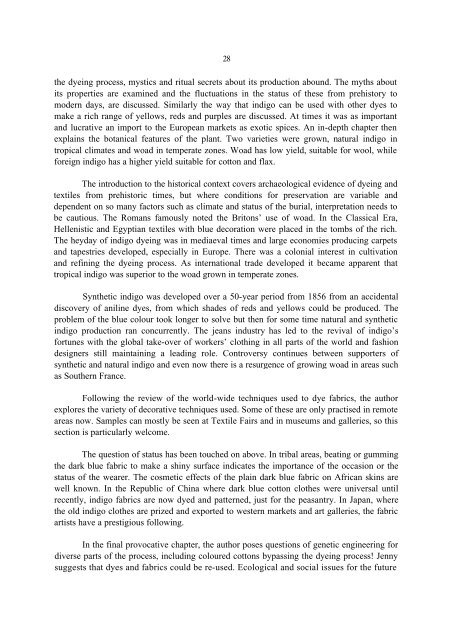download - OATG. Oxford Asian Textile Group
download - OATG. Oxford Asian Textile Group
download - OATG. Oxford Asian Textile Group
- No tags were found...
You also want an ePaper? Increase the reach of your titles
YUMPU automatically turns print PDFs into web optimized ePapers that Google loves.
28the dyeing process, mystics and ritual secrets about its production abound. The myths aboutits properties are examined and the fluctuations in the status of these from prehistory tomodern days, are discussed. Similarly the way that indigo can be used with other dyes tomake a rich range of yellows, reds and purples are discussed. At times it was as importantand lucrative an import to the European markets as exotic spices. An in-depth chapter thenexplains the botanical features of the plant. Two varieties were grown, natural indigo intropical climates and woad in temperate zones. Woad has low yield, suitable for wool, whileforeign indigo has a higher yield suitable for cotton and flax.The introduction to the historical context covers archaeological evidence of dyeing andtextiles from prehistoric times, but where conditions for preservation are variable anddependent on so many factors such as climate and status of the burial, interpretation needs tobe cautious. The Romans famously noted the Britons’ use of woad. In the Classical Era,Hellenistic and Egyptian textiles with blue decoration were placed in the tombs of the rich.The heyday of indigo dyeing was in mediaeval times and large economies producing carpetsand tapestries developed, especially in Europe. There was a colonial interest in cultivationand refining the dyeing process. As international trade developed it became apparent thattropical indigo was superior to the woad grown in temperate zones.Synthetic indigo was developed over a 50-year period from 1856 from an accidentaldiscovery of aniline dyes, from which shades of reds and yellows could be produced. Theproblem of the blue colour took longer to solve but then for some time natural and syntheticindigo production ran concurrently. The jeans industry has led to the revival of indigo’sfortunes with the global take-over of workers’ clothing in all parts of the world and fashiondesigners still maintaining a leading role. Controversy continues between supporters ofsynthetic and natural indigo and even now there is a resurgence of growing woad in areas suchas Southern France.Following the review of the world-wide techniques used to dye fabrics, the authorexplores the variety of decorative techniques used. Some of these are only practised in remoteareas now. Samples can mostly be seen at <strong>Textile</strong> Fairs and in museums and galleries, so thissection is particularly welcome.The question of status has been touched on above. In tribal areas, beating or gummingthe dark blue fabric to make a shiny surface indicates the importance of the occasion or thestatus of the wearer. The cosmetic effects of the plain dark blue fabric on African skins arewell known. In the Republic of China where dark blue cotton clothes were universal untilrecently, indigo fabrics are now dyed and patterned, just for the peasantry. In Japan, wherethe old indigo clothes are prized and exported to western markets and art galleries, the fabricartists have a prestigious following.In the final provocative chapter, the author poses questions of genetic engineering fordiverse parts of the process, including coloured cottons bypassing the dyeing process! Jennysuggests that dyes and fabrics could be re-used. Ecological and social issues for the future
















